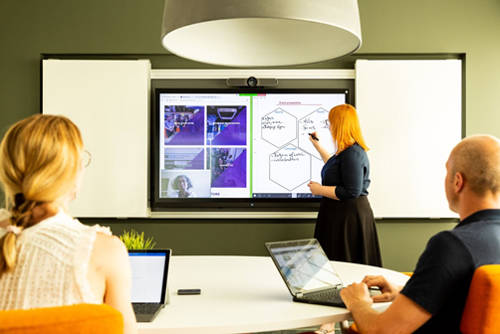For a business to thrive it needs to innovate to give it a competitive advantage over its competitors. Innovation sprouts from collaboration, the sharing of ideas from those with a common goal, to drive the business forward.
Modern technology has made it possible to tap into ideas from people all over the world who are able to join meetings from almost anywhere on the planet. This has brought about a seismic shift in how we see collaboration spaces.
Gone are the days of large conference rooms with cumbersome technology that almost never works and an environment that’s not very conducive to collaboration.
What businesses need now are smaller, intimate spaces with reliable tech that allows quick, spontaneous and productive meetings to push innovation-driven projects and ideas forward. The solution — huddle rooms.

What is a huddle room?
A huddle room is a small, informal space that accommodates 3 to 6 people. These versatile rooms usually include audio visual equipment with teleconferencing facilities and collaboration tools.
They function as private spaces where spontaneous, unplanned meetings and video calls with off-site teams or employees can take place at short notice. Depending on its size, a business can have one or several huddle rooms.
What are the benefits of a huddle room?
While a traditional boardroom still serves a function within a business, huddle rooms hold a number of benefits over large boardrooms:
- More efficient, more productive, and easier collaboration
Since teams are kept small, everyone is more engaged, focussed, and comfortable to share ideas. This makes meetings more productive and limits long, dragged out meetings so often associated with large boardrooms.
The small space also means that only those who really need to be there attend the meeting so others can continue working. At the same time, the spaces are also conducive to drop-ins by relevant team members when needed. What’s more, they provide a quiet, distraction-free space away from the now-ubiquitous open-plan office environment. - Decrease malfunctioning web conference meetings
Most technology installed in huddle rooms are purpose-built and designed in such a way to provide quick and easy access to on- and offsite meeting and collaboration tools.
This decreases the likelihood of malfunctioning web conference meetings which often cause problems due to unreliable internet connections, and slow or malfunctioning software. - Cost efficient use of space
Huddle rooms are versatile spaces that can be used for everything from meetings, presentations, client meetings, workspaces for mobile workers, one-on-one manager and staff meetings.
Their small size means that office space is used efficiently and more cost effectively. The equipment installed in huddle rooms are often cheaper than that required for big conference rooms. - No more booking
The idea of a huddle room is to create a space where ad hoc meetings can take place, however, some organizations still maintain a booking system for huddle rooms due to their popularity.
Nevertheless, since there are often more than one huddle room, booking lead times are usually short.
How to design your huddle room?
There is no question that huddle rooms are great for encouraging collaboration and innovation. But before you start knocking down walls and buying equipment, there are a number of things you must consider when designing a huddle room:
- Space requirements
How much space you require will depend on the size of teams and their collaboration needs. This will determine the type of furniture and how many team members the space will accommodate.
Some businesses have various sized spaces to fill specific needs. It’s important to think about how these rooms are going to be used, and how much space you have available in your office. - Technology needs
The same applies for the tech you install in huddle rooms. Some huddle rooms are strictly for quick meetings of on-site staff or clients, others are used for presentations, and sharing and collaborating with off-site team members.
This will determine the tech you choose, from video cameras, interactive touch screens, sound equipment, to connectivity tools. What’s important is that these need to be reliable, easy to use, and future proof. - Conferencing technology
In huddle rooms used for collaborating with off-site team members, the type of conferencing tools you choose is very important. There are different types of conferencing tools that are built to suit specific sized rooms.
These include high quality cameras that can adapt to room size, connected displays, and robust VoIP or standard telecommunications systems that ensure clear conference calls with multiple team members. One of the main factors for conferencing is quality and reliability. - Collaboration hardware & software
A feature of modern conferencing hardware such as the i3HUDDLE and software such as i3CAMPFIRE, i3NOTES and i3ALLSYNC is the ability to facilitate presentations, collaboration and sharing of ideas via easy-to-use interfaces such as digital whiteboards and shared document access.
Once again you need to determine what kind of tools you need to suit the way meetings are held in your business. Many hardware and software solutions can be customized to fit your particular needs. - Budget
Arguably one of the biggest considerations when setting up a huddle room is cost. How big is the room, what features do you really need, and will you be able to use it 5 years from now.
The rise in popularity of huddle rooms isn’t because they’re trendy, it’s because these spaces make a real contribution to the productivity of a businesses.
They allow ideas to develop quickly by facilitating and encouraging collaboration, driving innovation that’s so critical to success in the modern business environment.
i3-Technologies offers a wide range of hardware, software, and accessories to help your business set up the perfect huddle room.
Written by: Muriel De Bruyne on Tuesday, June 15, 2021